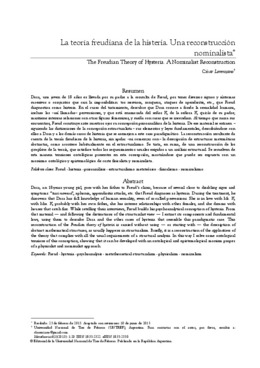La teoría freudiana de la histeria. Una reconstrucción nominalista
The freudian theory of hysteria. A nominalist reconstruction
Resumen
Dora, una joven de 18 años es llevada por su padre a la consulta de Freud, por tener diversos signos y síntomas sucesivos o conjuntos que casi la imposibilitan: tos nerviosa, ronquera, ataques de apendicitis, etc., que Freud diagnostica como histeria. En el curso del tratamiento, descubre que Dora conoce a fondo la sexualidad humana, incluso las –así llamadas– perversiones, y que está enamorada del señor K, de la señora K, quizás de su padre; mantiene intensas relaciones con otras figuras femeninas, y sueña con casas que se incendian. Al tiempo que narra sus encuentros, Freud construye ante nuestros ojos su concepción psicoanalítica de la histeria. De ese material se extraen –siguiendo las distinciones de la concepción estructuralista– sus elementos y leyes fundamentales, describiéndose con ellos a Dora y a los demás casos de histeria que se asemejen a este caso paradigmático. La reconstrucción resultante da cuenta de la teoría freudiana de la histeria, sin apelar –ni comenzar con– la descripción de estructuras matemáticas abstractas, como acontece habitualmente en el estructuralismo. Se trata, en suma, de una reconstrucción de los ejemplares de la teoría, que satisface todos los requerimientos usuales exigidos a un análisis estructural. Se resuelven de esta manera tensiones ontológicas presentes en esta concepción, mostrándose que puede ser expuesta con un monismo ontológico y epistemológico de corte fisicalista y nominalista. Dora, an 18-years young girl, goes with her father to Freud’s clinic, because of several close to disabling signs and symptoms: “tussi nervosa”, aphonia, appendicitis attacks, etc. that Freud diagnoses as hysteria. During the treatment, he discovers that Dora has full knowledge of human sexuality, even of so-called perversions. She is in love with Mr. K, with Mrs. K, probably with her own father, she has intense relationships with other females, and she dreams with houses that catch fire. While retelling their interviews, Freud builds his psychoanalytical conception of hysteria. From that material ― and following the distinctions of the structuralist view ― I extract its components and fundamental laws, using them to describe Dora and the other cases of hysteria that resemble this paradigmatic case. This reconstruction of the Freudian theory of hysteria is carried without using ― or starting with ― the description of abstract mathematical structures, as usually happens in structuralism. Briefly, it is a reconstruction of the applications of the theory that complies with all the usual requirements of a structural analysis. In this way I solve some ontological tensions of this conception, showing that it can be developed with an ontological and epistemological monism proper of a physicalist and nominalist approach.

